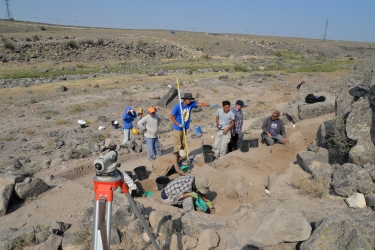Armenian Archaeology Lecture Series Begins with Focus on Earliest Farmers of Caucasus

On September 16, 2020, more than 100 participants attended the first of a four-part remote lecture series on the latest discoveries in Armenian archaeology as part of the Fourth Hampartzoum and Ovsanna Chijtian Conference on Armenian Studies, presented by the Cotsen Institute of Archaeology at UCLA. “The Earliest Farmers of the Caucasus: A View from Masis Blur,” was co-hosted by Kristine Martirosyan-Olshansky, postdoctoral scholar and director of the H. O. Z. Chitjian Armenian Laboratory at the Cotsen Institute, and Alan Farahani, assistant professor of anthropology at the University of Nevada, Las Vegas and a former postdoctoral scholar at the Cotsen Institute. A recording of this event has been posted to the Cotsen Institute of Archaeology YouTube channel. The lecture series, “Archaeology of Armenia: Earliest Settlements, Dragon Stones, and Gods of Urartu” will include three additional virtual lectures starting Friday, October 16 at noon Pacific Time and continuing at the same time through October and November.
 The presentation of September 16 was dedicated to the memory of Gregory Areshian, an expert on Armenian archaeology and a member of the UCLA community since 2001, who passed away in Armenia in August 2020. It offered a summary of the research conducted at the archaeological site of Masis Blur, an early farming community located in the Ararat plain of Armenia, occupied continuously for nearly a millennium from around 6200 cal. BCE to 5200 cal. BCE. Martirosyan-Olshanky explained that “under normal circumstances, we would have organized the fourth Chitjian conference on Armenian Archaeology and Ethnography, which usually brings together scholars from across the world who present on their areas of expertise as it relates to various aspects of Armenian culture, history, and language. Out of necessity, due to the pandemic and because the participants are in different time zones, we decided on a mini-lecture series. But the lectures, presented by our Armenian colleagues, will still cover around 7000 years of cultural development in the region from the first farmers to the first empire.”
The presentation of September 16 was dedicated to the memory of Gregory Areshian, an expert on Armenian archaeology and a member of the UCLA community since 2001, who passed away in Armenia in August 2020. It offered a summary of the research conducted at the archaeological site of Masis Blur, an early farming community located in the Ararat plain of Armenia, occupied continuously for nearly a millennium from around 6200 cal. BCE to 5200 cal. BCE. Martirosyan-Olshanky explained that “under normal circumstances, we would have organized the fourth Chitjian conference on Armenian Archaeology and Ethnography, which usually brings together scholars from across the world who present on their areas of expertise as it relates to various aspects of Armenian culture, history, and language. Out of necessity, due to the pandemic and because the participants are in different time zones, we decided on a mini-lecture series. But the lectures, presented by our Armenian colleagues, will still cover around 7000 years of cultural development in the region from the first farmers to the first empire.”
Following is a schedule for the remaining lectures in the series (contingent on the developing situation in Armenia):
Dragon Stones of Armenia: Recent Research and How Protection Works.
Arsen Bobokhyan, vice director, Institute of Archaeology and Ethnography, National Academy of Sciences of the Republic of Armenia.
In the high mountains of Armenia, unique monuments preserved to this day are traditionally called by the locals “vishapakar” or dragon stones. Although vishapakars were discovered more than a century ago, their secrets are far from completely deciphered.
The Gods of Urartu: The Religious beliefs of the Urartian Empire
Miqayel Badalyan, director of the “Erebuni” Historical & Archaeological Museum-Reserve, Yerevan, Republic of Armenia.
The religious belief system of the Urartian Empire, the first empire of the Armenian Highlands and the first people to have writing, will be discussed in terms of the archaeological data, philological and visual art sources.
New Light on the Neolithization of the Armenia and Beyond: Data from The Recent Excavation at Lernagog-1 site and Areni-2 Cave in Armenia.
Artur Petrosyan, researcher, Department of Early Archaeology, Institute of Archaeology and Ethnography, National Academy of Sciences of the Republic of Armenia.
Fieldwork activities implemented during the last 20 years have resulted in the discovery of a series of Old and Early Holocene sites in Armenia, Georgia, and Azerbaijan. Sites included stratified cave and rock-shelters, as well as open-air sites and settlements, filling the gap between the 10th and early 6th millennium BC.
Published on September 30, 2020.


